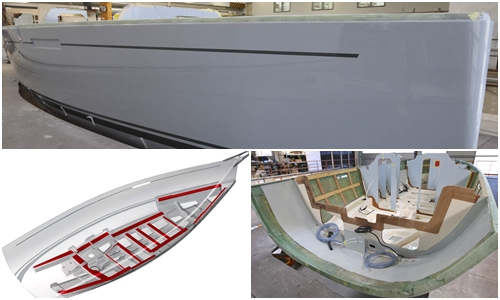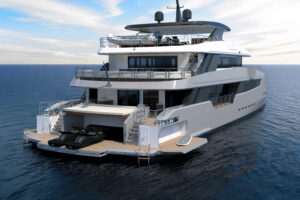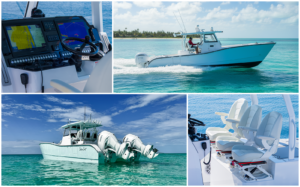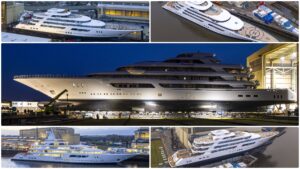Dehler 34
A unique hull for a pioneering yacht
Last week the first Dehler 34 hull with a length of 10.30 m and a width of 3.60 m has been demoulded and will now enter the assembly line of the Dehler shipyard in Greifswald, Germany. This moment represents an important milestone in the production of every newly developed yacht and was closely watched by the Dehler team.
The hull for the new Dehler 34 is, as customary for Dehler, built with a full sandwich core and differentiates itself from others with some special features. The full sandwich construction offers higher stiffness, very good insulation and is significantly lighter than yachts with other construction methods. When the sandwich construction is viewed in detail, the first layer from the outside is the so-called gel coat, which represents the shell of the hull.
The cove line of Dehler yachts is not glued on to the hull but integrated into the gelcoat, to ensure durability. The first layer behind the gelcoat , the “outer skin” of a sandwich construction, consists of fiberglass, which is processed with vinyl esters.
The advantage of vinyl ester is its osmosis resistance, which ensures a long life of the yacht. The 16mm thick sandwich core is made of balsa wood that gives optimal insulation and makes the hull as light as possible. The final layer, the “inner skin”, completes the sandwich method.
Subsequently, the floor structure is installed, which distributes the forces on to the hull. Here again, Dehler differentiates itself from other series yacht producers with the Dehler Carbon Cage.
In the next step, the interior components will be installed before the deck will be connected to the hull. The new Dehler 34 will be completed just in time for the autumn boat show season.
What is the Dehler Carbon Cage and how does it work?
What has been a steel frame in the first Dehler 34 in the 80s, is now the Dehler Carbon Cage. But how is it constructed and what are the advantages in comparison to conventional building methods?
We would like to use the new Dehler 34 to answer this question in more detail.
The Dehler Carbon Cage (highlighted in red) was developed in collaboration with judel/vroljik & co and gives the Dehler 34 a higher rigidity.
The floor structure, which is the backbone of a yacht is reinforced with uni-directional carbon fiber at strategic points.
The Dehler Carbon Cage thereby increases the rigidity of the floor structure by 20%. The mast base is even 50% stronger, providing an ideal force distribution.
Especially on sailing yachts a stable structure is of advantage since it directly affects the sailing performance.
This unique step in series yacht building allows the Dehler 34 to go closer to the wind than other series production yachts, as the tension of the rig remains consistently high even in rough seas. This benefits not only the ambitious sailors, but also increases the general sailing fun on board of the new Dehler 34. Also the trust of the owner in the longevity of his Dehler 34 is strengthened by this innovation.


